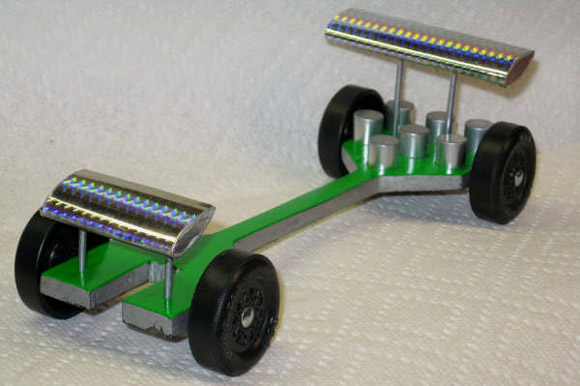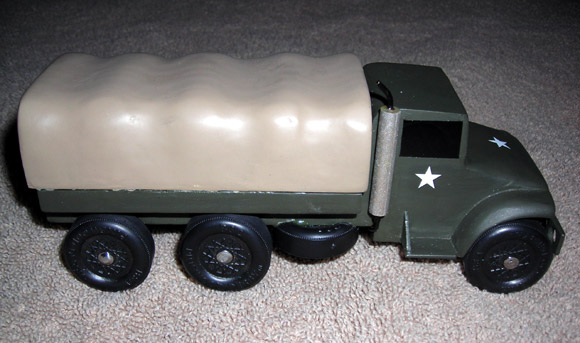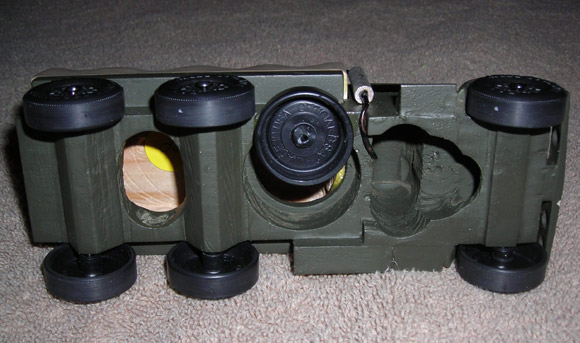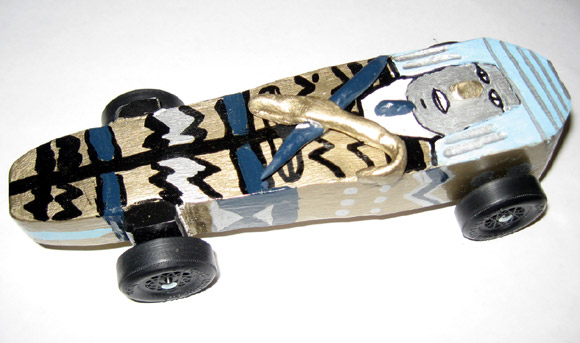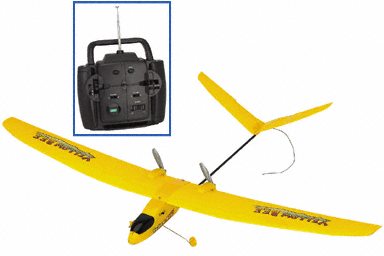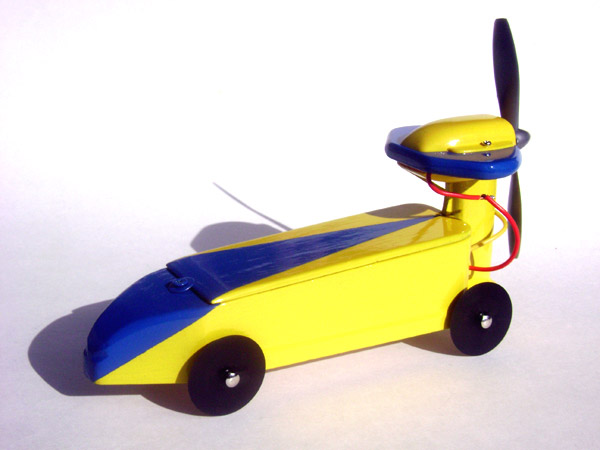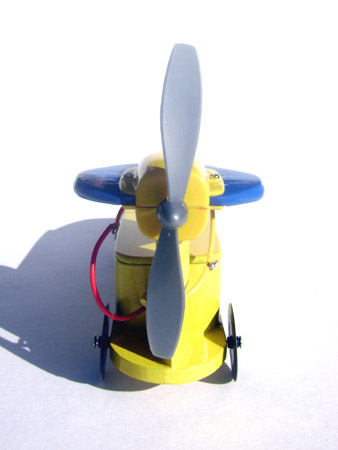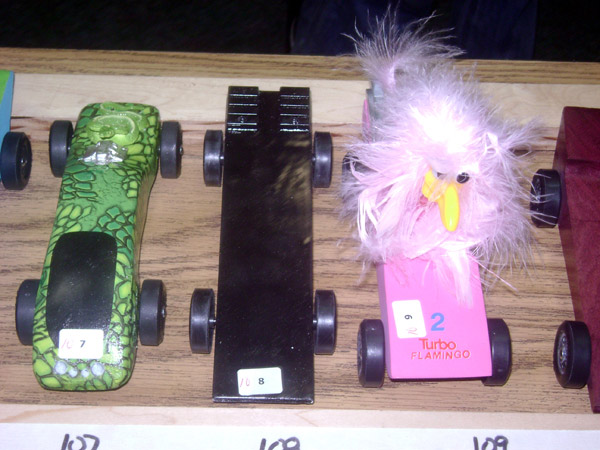– Feature Article – Pinewood Derby Kit History
– Pinewood Derby Car Showcase
– Memory – Screaming Mimi
– Q&A
Pinewood Derby Kit History
As you probably know, pinewood derby racing began in 1953, when Cubmaster Don Murphy developed and implemented the concept. It didn’t take long for the idea to catch on, and in 1956, BSA contracted with Beta Crafts to produce official BSA kits. Although the basic concept of the pinewood derby race has not changed since 1953, the kits have undergone dramatic changes.
This article will walk through the changes to the official BSA kit from 1956 to the present. I will identify the various kits that were produced; many of which are still commonly found on eBay. (Please ignore the red numbered dots – I used these to keep the kits organized)
Original Kit – 1956
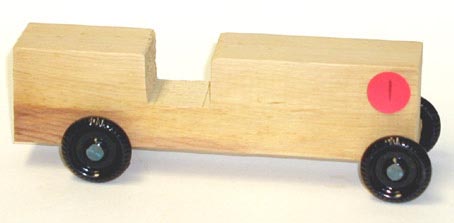
The first official kit was used for over 20 years. The kits were sold in unpackaged bulk sets, as well as individual shrink-wrapped kits. The large nail axles were not placed directly into the block, but instead were inserted into wooden axle supports, which were glued into notches in the bottom of the block. Also, as be can be seen, this kit used narrow wheels; and the block is 1-3/4 inches tall with a large ‘cockpit’ cutout.
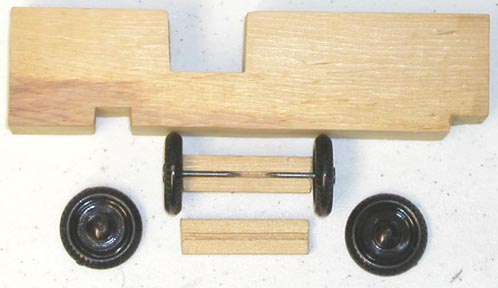
Grand Prix Pinewood Derby – 1977
In 1977, a new version of the kit was introduced with several fundamental changes: (1) offset the axle positions to approximately the current position, (2) 1-1/4 inches tall with a small cockpit, and (3) new, wider profile wheels. This kit also introduced the current kit name of “Grand Prix Pinewood Derby”. This kit was only produced for a few years, so it is relatively rare to find one in the original packaging. Cars built from this kit can be identified by the wooden axle struts in the modern position.
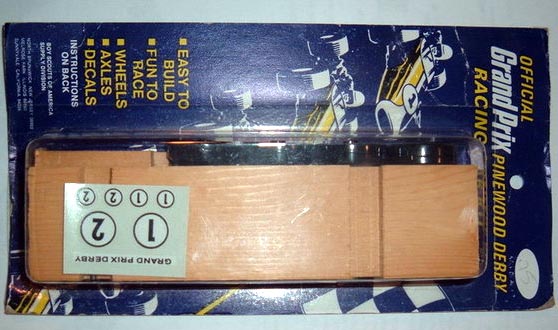
(Photo courtesy of Rick Sanner)
Redesign – 1980
The next iteration eliminated the axle supports, and introduced the axle slots on the bottom of the block. At this point the kit virtually resembled the modern kit, except for the presence of the cockpit. Cars built from this kit can be identified by the acronym ‘CMI’ as raised letters on the wheel sidewalls. CMI stands for ‘Consolidated Models Incorporated’, which is the parent company of Beta Crafts.
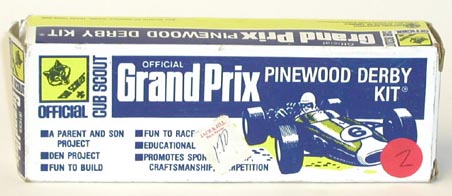
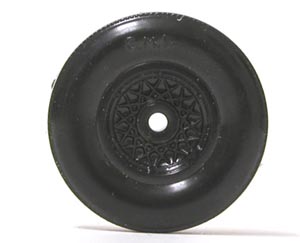
New Wheels – 1988
A minor kit change occurred in 1988. Other than the packaging change, there were subtle changes in the block and axles, while the wheels were improved. The new wheels had blank sidewalls, and raised lettering inside the wheels.
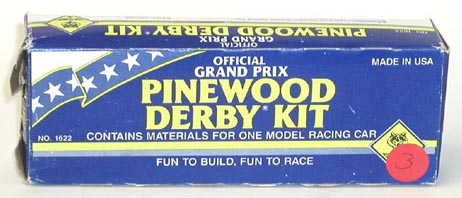
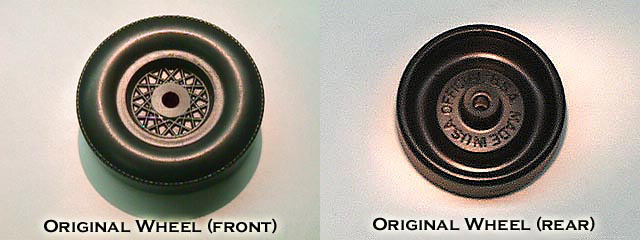
(Photos from Don De Young at Pinewood Derby Mania)
Bar Code Kit
The next iteration was only a change to the packaging, and the addition of a bar code. Unfortunately I have not been able to ascertain the date of introduction of this kit.
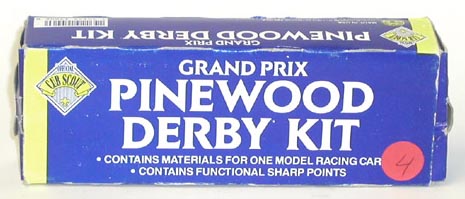
Modern Box – Black End Flaps
Beta Crafts then introduced a kit with a box similar to the current box, but with a black end flap. The kit itself was modified to eliminate (finally) the cockpit. Again, I have not been able to ascertain the date of introduction of this kit.
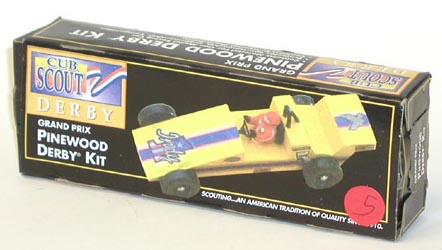
New Manufacturer 1998
In 1998, BSA began purchasing kits from Homecrafters Manufacturing (now known as Kahoot). The Kahoot kits used the same modern box, but the end flaps were orange. Initially, the Kahoot kits used a unique wheel. This was soon changed to the modern wheel design, so kits with the unique wheel design are rare. In 1999, the kit contract was given exclusively to Homecrafters.
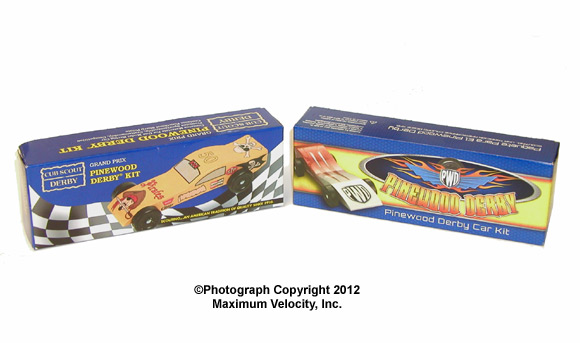
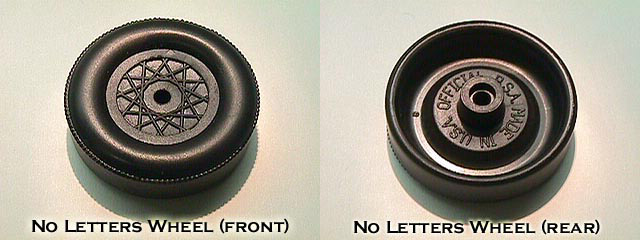
(Photos from Don De Young at Pinewood Derby Mania)
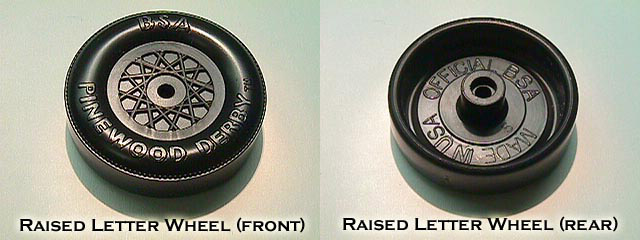
(Photos from Don De Young at Pinewood Derby Mania)
Recent Changes
Since 1999, there have been few changes. Most noticeably, the current box now sports sealed end flaps instead of tucked end flaps. This was done to keep the nails and papers from falling out, and for “security”. In addition, the mold numbers changed this year from 1-18 skipping 6 and 7, to 1-16.
Alternate Kits
With the widespread adoption of pinewood derby style events by many non-BSA organizations, various alternate kits flourish from many manufacturers, ranging from vintage to modern styles. If you are interested in trying a vintage-style kit, they are still manufactured by Beta Crafts.
Acknowledgment
I would like to thank Art Hasselbach of Beta Crafts for his assistance with this article.
Pinewood Derby Car Showcase
Green Airfoil: Bob Drag
This is the car my son, Glenn, entered for his Pack’s, 2008, Pinewood Derby. This design features an extended wheel base, with a COG approximately 7/8 inch forward of the rear axle hole. The weights consisted of 3.5 ounces of tungsten cylinders. Overall weight was dead on at 5 ounces. The airfoils were made from 3/4 inch aluminum streamline tubing. The front airfoil helped us create a high ‘front end’ that was still inline with the front of the car in order to take advantage of the forked body. And, it allowed us to keep a maximum distance on the wheelbase. Now, we never expected the airfoils to add any aerodynamic advantage, but in the mind of an 8-year old if it looks fast, it goes fast! And, when the car was unveiled on race day, the ‘8-year old mind’ in a lot of parents sure took over. The intimidation factor was off the charts. But, the end result paid off for all the hard work that went into the building of the car. Glenn’s car was the fastest at his level and the bonus was the 2nd place for best design. Since our Pack does not run an overall Pack championship race, the next stop is the Council race.
Deuce and a Half: Robert Knapp
This year I decided to build a replica of the Deuce and a Half I once owned. It is a 1952 GMC M-211. I made the truck with two derby kits and a 2×4 for the cargo area. By hollowing out the underside of the truck I was able to get the weight down to 4.9 ounces, it is also regulation length measuring 7 inches. Two of the rear wheels were raised using the Pro-Body tool. The truck performed well in the parent-sibling race. It seemed to be a hit with the kids as well.
Carcophagus: Kyle Wilson
My son wanted to do ‘Most Unique’ car again this year. He has tried this every year since winning it as a Tiger. Since he was doing a school project on Egypt, he was ‘bitten’ by the mummy bug. He came up with “Carcophagus”. It was a pretty cool idea. The most involved part was the painting. I put the tungsten weights in the back above the wheels. I drilled a little hole underneath for the tungsten putty. This was great for adding .01 ounce.
On race day, he shocked everyone! He pulled the fastest time of the day on his first run. It was 2.574 seconds. Most scouts were in the 2.6 range. It just didn’t look fast. He won the next two races also with times under 2.6 seconds. He was well on his way to the top speed.Then on his last run, he was leading a good bit, when the car suddenly slowed down one foot from the finish. It finished with a 2.8 seconds.
I couldn’t believe it! Then someone picked up something from his lane and handed it to me ! It was that tungsten putty. It had fallen out from underneath his car ! I felt devastated. This was MY fault for not jamming that putty in the cavity HARD. I still haven’t forgiven myself. I’ll give credit to my son; he took it better than I did. He just asked if we were still going to Dairy Queen afterwards. Of course we did! I am so proud of him and his car. Lesson: jam that putty in there after it passes weigh in.
Editor’s Note: Tungsten Putty will stay much better in a smaller, deeper hole, than in a larger, shallower hold.
Pinewood Derby Memory
Screaming Mimi
For our Open Division, the rules are basically that it must fit the track, not interfere with other cars, not have anything hazardous (like mercury), but still be no more than 5 ounces (got to make it a challenge). Last year I used razor wheels and needle axles with my “Wind Tunnel” car to win the open division.
For this year, I drew inspiration from Randy Davis’ prop cars. Last year, I bought an RC airplane from Harbor Freight, for all of $29.99, and got some good flying out of it. We also got a few good crashes (broke a wing and a major crack in the fuselage from a nose dive). I figured that I’d give that plane a second life as a Pinewood Derby car.
Here’s what I started with:
So, I gutted the electronics, cut up the plastic engine mounts to use with the car. With the motor and the battery pack (essentially 4 AA batteries), it was going to be a challenge to make the 5 ounce limit. I had to use a lot of balsa and ordered some razor wheels from Maximum Velocity to save on weight. The only pine in the car is a thin sliver of the base, but even much of that was replaced with balsa.
So, here’s what I ended up with. I call it the “Screaming Mimi”:
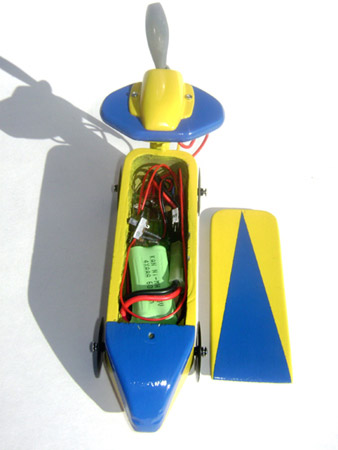
One of the dents you see on the nose was from a test run on my floor. The car hit a door jamb, so I made a matching dent on the other side to make it a part of the design.
Results: It blew the competition away. Pun intended. Literally so, in one heat (keep reading).
Heat 1: As soon as the cars were released, I hit the throttle on the remote control. Zoom… Then I cut power as it crossed the finish. Up to that point of the race, the fastest time was 3.032 secs (208.0 scale mph) on a 40 foot Piantedosi aluminum track. It came in at 1.999 secs, 315.5 mph.
There were high five’s all around.
Heat 2: Zoom… This time it was 1.957 secs, 322.3 mph, its fastest run.
Heat 3: This one was going to be interesting. It was in the lane next to the bird car (complete with ostrich feathers). Zoom… Feathers go flying! Guys were joking about a bird strike. Fortunately, the damage wasn’t too bad to the bird car.
Heat 4: Matched up against Evan’s “Always on Time” car. What I didn’t know was that while Evan was helping pre-stage the cars, he opened the hatch to my car and turned off the switch to the battery. You can see the switch in one of the photos above. So, the gate drops and I’m trying to hit the throttle, but nothing is happening!?! Laughs all around. Guess what…It still beat his car and won the heat. A fact which I had to rub in with Evan.
I disqualified myself afterwards, when we were announcing the results. So, Evan ended up with the official “bragging rights” for the open division. I was just doing it for the fun of it.
I wish I had it all on video. I even brought a video camera, but forgot all about it.
Randy Lisano
Originally posted on derbytalk.com
Used by Permission
Q&A
One of the rules is the one about the 7 inch length: Now, is that the maximum length, or can we make it shorter than that and still have it be legal? My 8 year old son has chosen an old-time car design (sort of like the model “A.”), but the design that he wants to use may require taking some of the length off of the back of the block.
The 7 inch rule is a maximum, so you can go shorter. However, please note that full length cars do tend to perform better than shorter cars.
How do I add weight to the car so that the balance point ends up close to the target of 3/4 to 1 inch in front of the rear axle?
Each design is a little different, but as a rule of thumb place 1/3 of the added weight behind the rear axle, 1/3 above the rear axle, and 1/3 an inch or two in front of the rear axle. Also, it is best to orient the closest slot towards the rear of the car (e.g. on a Cub Scout block, use the slot that measures just under 1 inch from the end of the block as the rear axle).
I am in an open race and am trying to decide whether to use bearings. Would I be better off using bearings on a five ounce car, or going with similar wheels (but regular axles) on a 10 ounce car?
I have not directly tested this, but can make a suggestion based on the following test data.
At 5 ounces, bearing cars are about 0.12 seconds faster than non-bearing cars (all else being equal, on a 32 foot aluminum track).
A 10 ounce car is about 0.06 faster than a 5 ounce car (all else being equal, on a 32 foot aluminum track).
So, I would go with the 5 ounce car with bearings, over a heavier car without bearings.
Want Answers?
Do you have a pinewood derby-related question? If so, e-mail us your question.We answer all questions by e-mail, but not every question will appear in the Q&A section of the newsletter.
Back Issues
Are you a new subscriber, or have you missed some of the previous newsletters? Don’t miss out; all of the issues for Volume 5 through Volume 17 are posted on our web site.
Newsletter Contributions
We welcome your contributions. If you would like to contribute an article, a web site review, a speed tip, or a pinewood derby memory, please e-mail us.
Subscription Information
The Pinewood Derby Times is a free e-newsletter focused on pinewood derby racing. It is published biweekly from October through March.
If you haven’t already done so, please forward this issue to your pinewood derby friends. But please don’t subscribe your friends. Let them decide for themselves. Thanks.
If this newsletter was forwarded to you, why not subscribe to receive this newsletter. There is no cost, and your e-mail address is safe, as we never sell or share our distribution list.
To subscribe, send a blank e-mail to
[email protected]
You will receive a confirmation e-mail. Reply to the confirmation e-mail and you will start receiving the Pinewood Derby Times with the next issue.
Randy Davis, Editor, Pinewood Derby Times
E-Mail: [email protected]
(C)2018, Maximum Velocity, Inc. All rights reserved. Please do not reprint or place this newsletter on your web site without explicit permission. However, if you like this newsletter we grant permission, and encourage you to e-mail it to a friend.
Maximum Velocity disclaims any personal loss or liability caused by utilization of any information presented in this newsletter.
The Pinewood Derby Times is not specific to, and is not affiliated with the Boy Scouts of America, YMCA, Awana, or any other organization.
(R)Maximum Velocity is a registered trademark of Maximum Velocity, Inc.
(R)Pinewood Derby is a registered trademarks of the Boys Scouts of America.
(R)Awana is a registered trademark of Awana Clubs International.
All other names are trademarks of their respective owners.

